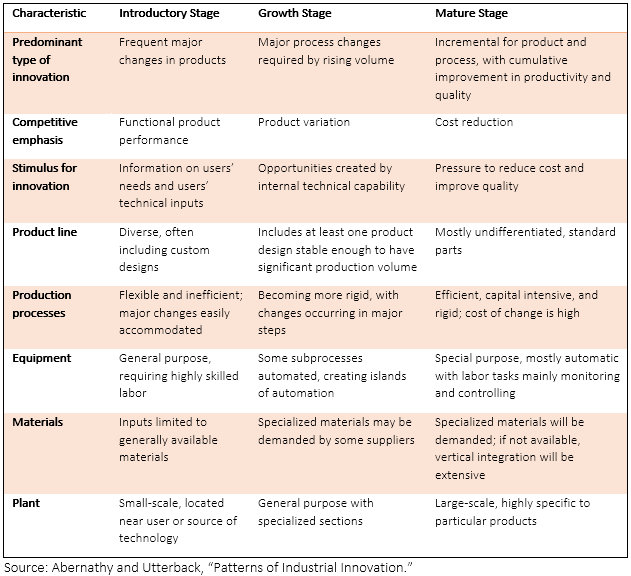The focus and characteristics of innovation tend to vary with the maturity of a product or technology. (See Table 1.) During the early stages of a major technology, there are often significantly different approaches that compete on functional performance. Historic examples include early automobiles where steam, electric and gasoline powered models competed, and early personal computing, where companies offered products with differing, incompatible architectures and operating systems. Typically, as the technology enters the growth phase, industry will settle on a smaller number of standard types with competition becoming more sensitive to cost and, often, profit margins decreasing. Businesses will seek to improve and differentiate their products through new features, components, and services while trying to lower production costs. As a product becomes commodity-like, cost reduction, which can include energy-related savings, becomes the competitive focus along with some enhancements in quality.
However, at times the trajectory of a product or technology may also be disrupted by fundamental product and production changes (for example, LED versus incandescent and fluorescent lamps) or by enabling new and greater functions and services (for instance, mobile phones disrupting landline telephony while also enabling many other computing and communication services).
Both incremental and fundamental innovations are critical to advancing economic development and productivity; improving the quality, affordability, and range of products and services; and supporting energy and environmental performance objectives.
Table 1. Characteristics of Innovation in Different Phases of Industrial Development

In the energy sector, innovations can take many forms, affecting products, processes, and services. New technologies can serve new functions or better perform existing functions. Existing technologies can be applied innovatively to meet new needs.
While eyes and investor dollars are often drawn to major new emerging technological opportunities (e.g., improved photovoltaics, next generation nuclear reactors, carbon capture chemical processes, advanced energy storage, smart buildings and energy controls), many innovations provide incremental improvements in cost, performance, and quality of existing products and services that collectively deliver great advances and benefits. All of these, emerging from entrepreneurial start-ups hatched in university labs, corporate R&D, National Laboratories, shop-floor tweaks, customer insights, and elsewhere, are vital to advancing clean energy technologies.